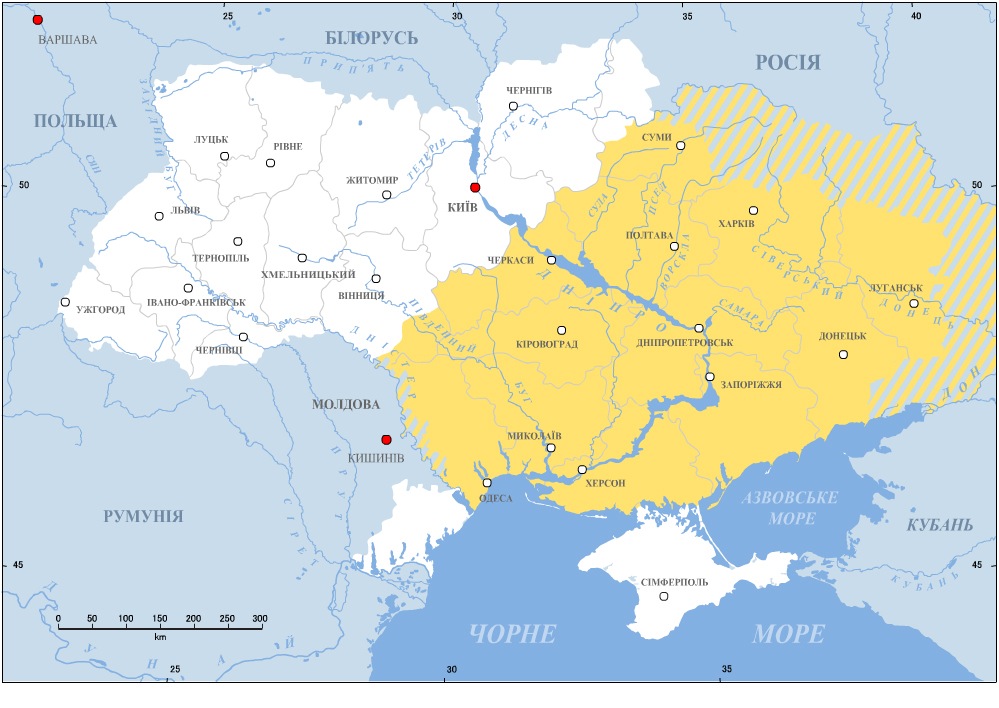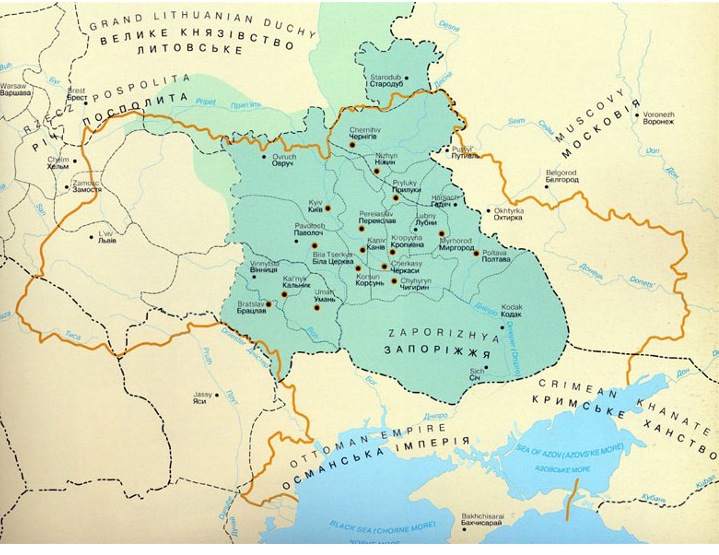COSSACKS

Crucifixion with a Cossack general, late seventeenth century, National Art Museum, Kyiv, Milyaeva: Ukrainian Icon, no 67. From a church in Poltava.
Oppressed by a Catholic nobility and by Jewish middlemen, many Orthodox Ruthenian peasants fled eastwards to 'Zaporizhia' - the 'land beyond the rapids' of the Dnieper river, land that was outside the direct control of the Polish or Russian governments. Here they were in contact with the already established Cossacks. The word 'Cossack' apparently derives from the Turkic word 'Kazak', as in Kazakstan', meaning 'free man'. The Cossacks were self governing but ready to sell their services to the established states, mainly to guard them against the Crimean Tatars, but also on occasion to support one side or the other in the numerous complicated wars of the area. The Tatars still held the whole Black Sea and Azov coastline including, of course, Crimea. It is at this point, I think, that the word 'Ukraine', meaning frontier, begins to be relevant. When Ukrainians talk about 'Ukraine' they are referring to the name of a country; when Russians talk about 'the Ukraine' they are referring to a frontier - the land separating Poland and Russia and the Tatars. On the Russian side of the frontier there were the 'Don Cossacks', and on the Polish side there were the so-called 'registered Cossacks', notionally loyal to the Polish army, but Orthodox, largely made up of dissidents from the Polish system. The 'Zaporozhian host' of escaped Orthodox serfs constituted a third Cossack force, unrecognised by the Polish government.

The 'wild fields' in the seventeenth century - the area effectively outside government control - superimposed on the contour of modern (pre-2014) Ukraine. The striped area is a prolongation of the wild fields in an area that is now part of Russia.
Another, more intellectual, defence of Orthodoxy was mounted through the establishment, largely under Cossack patronage, of the 'Greek Slavonic Academy of Kiev', opened in 1632, which, under Peter Moghila, a monk in the Kiev Caves monastery who was made Metropolitan of Kiev in 1633, became possibly the first serious centre of theological learning in Russian Church history. Peter, however, who came from a princely family in Moldavia, had himself received a thoroughly Catholic education in Western schools and universities. The teaching in the Kiev Academy (for a priesthood performing offices in Church Slavonic for largely Ukrainian speaking congregations) was in Latin and had a distinctly scholastic character. He was basically using Catholic weapons to counter Catholicism and the Unia. In 1997, the Orthodox Church of Ukraine - still under Moscow but with a large degree of autonomy - declared him to be a saint but this has not been generally accepted throughout the Orthodox world.
The 'Khmelnitsky rising' of 1648, with its devastating effect on the situation of the Jews in Poland, is discussed in my earlier 'Polish prologue' article. It established at least briefly an independent state - the 'hetmanate' - that straddled the Dnieper and could be seen as the first Ukrainian state if we don't count Kievan Rus' itself and its various derived principalities prior to the Tatar assault and the Polish-Lithuanian takeover. However, the two banks of the Dnieper, the right (West) and left (East), (9) fell out with each other in what Ukrainian historians call 'the ruin.' The Western Cossacks tended to ally with the Poles, the Eastern Cossacks with the Russians, so that eventually the territory East of the river fell into the Muscovite sphere of influence. But this was by no means a simple process. At the Battle of Poltava in 1709, when the Russian Tsar Peter I ('the Great') defeated the Swedish Charles XII, the Cossacks of the hetmanate under the hetman Ivan Mazepa, was fighting for Charles (after previously following a fairly consistent pro-Moscow policy). He fled to Moldavia, then in Ottoman hands, where he died. (10)
(9) Which can be a little confusing because of course looking at a map the West is on the left and the East is on the right.
(10) Moldavia and Wallachia make up modern Rumania. They had submitted voluntarily to the Ottomans and were therefore allowed a certain degree of independence, becoming a citadel of Orthodox culture. Modern Moldova is part of Moldavia that was incorporated into the Soviet Union. and is now an independent state.
By this time, it should be said, Moscow was back in communion with Constantinople. This happened in 1589, when the Patriarch of Constantinople, Jeremiah II, acting according to Pospielovsky, p.67, under duress, established Moscow as an autonomous patriarchy. In 1686, recognised by Constantinople in 1687, the Kiev metropolitanate was brought under the control of the Moscow patriarchate. This is the act which the present Patriarch of Constantinople, Bartholomew, rescinded when he recognised the autonomy of the Kyiv patriarchate. It occurred at a time when the Russian church was in some disarray through the schism with the 'Old Believers' prompted by liturgical reforms introduced by the Patriarch Nikon. In the early eighteenth century, in effect from 1700, formally from 1721, Peter suppressed the Moscow patriarchate, replacing it with the 'Holy Synod', which could be seen as simply a government department. The present Moscow patriarchate came into existence as part of the February revolution in 1917. (11)
(11) I gave an account of the creation of the Moscow patriarchate in 1917, together with a brief account of the earlier history in my essay 'The Moscow Patriarchate and the Bolshevik Revolution', Problems no 32, 2017, http://www.peterbrooke.org/politics-and-theology/moscow/
The 'spiritual regulation' which established the Holy Synod was, as it happens, devised by the Rector of the Kiev academy, Theophan Prokopovich. The twentieth century Orthodox theologian, George Florovsky in his The Ways of Russian Theology, complains that the early eighteenth century saw what he calls a 'ukrainisation' of the Russian church. But where Moghila was suspected of having a Catholic caste of mind, Prokopovich, also educated in European universities, had reacted strongly against Catholicism and, according to Florovsky, was not just influenced by Protestantism but should be seen as part of the history of Protestantism. The education of the higher clergy in Russia was now remodelled along the lines of the Kiev Academy.
Poland suppressed its registered Cossacks in 1700 and recovered control of the western side of the Dnieper in 1714. The area had been devastated by the wars and the Poles set about repopulating it. Following the Encyclopedia of Ukraine account ('History of Ukraine'):
'Peasants from northwestern Ukraine, especially Volhynia, were attracted there by 15-to-20-year exemptions from corvée and other obligations. With them came Orthodox and Uniate clergy. Cossackdom, however, was not allowed to develop. The towns that were re-established were largely inhabited by Jews, who earned their living as innkeepers, artisans, and merchants. Polish gentry were largely attendants at the magnates' courts, and leaseholders or stewards managed their estates. At the peak of the social order were the few wealthy magnate families that owned huge latifundia. For much of the 18th century the Right Bank was a typical noble-dominated society, marked by lack of central authority, oligarchic politics, and extreme exploitation of the peasantry.'
There were periodical peasant revolts known has 'haidamakas', especially after the corvée system (forced unpaid labour) was reintroduced:
'The most widespread and bloodiest was the so-called Kollivshchyna rebellion of 1768, when the Poles were engaged in another war with Russia ... Thousands of Polish nobles, Jews, and Catholic clergy were massacred. Fearing that rebellion would spread into its possessions, the Russian government sent forces to quell it. Thus ended the last great uprising of the Ukrainian peasantry against the Polish nobles.'
This of course was on the eve of the collapse of the Polish state when, between 1772 and 1795, it was divided up between Austria, Russia and Prussia.
On the left (East) bank of the Dnieper the Cossacks continued to have a semi-independent existence. The 'hetmanate', derived from Khmelnitsky, occupied and had limited sovereignty over the areas corresponding to the modern Kyiv and Chernihiv oblasts in the North of the modern Ukraine, on the border with Belarus. (12) Relations with the Russian government were determined by the 'Hetman Articles', starting with the Treaty of Pereislav made with Khmelnitsky in 1654. The articles were renewed with every successive hetman and steadily inflected in Moscow's favour, which also meant a steady conversion of the ruling Cossack elders into a landowning aristocracy on the Russian model and the reduction of ordinary peasants and Cossacks to a state of serfdom. In 1764, under Catherine II ('the Great'), the office of hetman was abolished and replaced by a Moscow controlled 'Little Russian Collegium'.
(12) I am for the moment unable to explain why Belarus has a moral and political existence separate from Ukraine - its history is very similar but of course it wasn't on the frontier with the Tatars and didn't have Cossacks. It seems therefore to have been more thoroughly integrated into the Polish system. While the Cossacks were hostile to any hint of Catholicism, the Uniate Church was well established in Belarus.

The hetmanate at the time of its greatest extention, presumably 1650s-60s, prior to the Ruin, when it still straddled the Dnieper, superimposed on the contour of modern (pre-2014) Ukraine.
South of the hetmanate the Zaporozhian Cossacks continued in existence in a territory that included what was to become Yekaterinoslav (now Dnipropetrosvk) and stretched across into the west bank of the Dnieper, bordering on the territory held by the Crimean Tatars. They too had been allied with Ivan Mazepa and Charles XII in the Battle of Poltava and had to take refuge with the Tatars in Crimea. They returned but under tighter control from Moscow. Starting in 1752, Moscow began a policy of settling Serbs in their territory. As in the hetmanate, there was a continual process of converting the Cossack leadership into a landed aristocracy.
Following the account in the Encyclopedia: 'After the Russo-Turkish War of 1768–74 and the Peace Treaty of Küçük Kaynarca [when Russia got control of Crimea - PB], the liquidation of Ukrainian autonomy gained new impetus. The Zaporozhian New Sich was destroyed by Russian troops in 1775; many of the dispersed Zaporozhian Cossacks fled and established the Danubian Sich and the vast lands of Southern Ukraine were incorporated into the Russian Empire as part of New Russia gubernia and Azov gubernia and developed by their governor Grigorii Potemkin. Catherine promoted the settlement of these largely unpopulated areas by Germans, Serbs, Mennonites, Bulgarians and others, and the establishment of several new cities on the Black Sea and Sea of Azov to attract foreign trade.'
This is broadly the territory which is being occupied by the Russians at the time of writing. The Encyclopedia's use of the term 'Ukraine' to describe lands that were at the time mostly under Tatar control is a little tendentious.
We have come to the eve of the Polish partitions when, particularly in the 1793 and 1795 partitions, Russia got hold of most of the area that is now modern Ukraine, West of the Dnieper. It is quite clear, I think, that we are talking about a people who, despite their common origins, are quite distinct from the Russians and who maintained their own Orthodox culture despite the considerable pressure put on them to become Poles. The process by which they develop a sense of themselves as a coherent nation will be looked at in the following article.